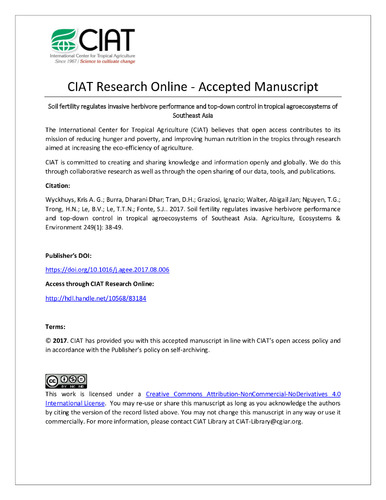Soil fertility regulates invasive herbivore performance and top-down control in tropical agroecosystems of Southeast Asia
Abstract
In terrestrial ecosystems, changes in soil nutrient availability, plant growth or natural enemies can generate important shifts in abundance of organisms at various trophic levels. In agroecosystems the performance of (invasive) herbivores and their impacts on crops is of particular concern. Scientists are presently challenged with making reliable inferences on invader success, natural enemy performance and efficacy of biological control, particularly in tropical agroecosystems. In this study, we assess how trophic regulatory forces (bottom-up vs. top down) influence the success of three globally important pests of cassava. We examine the mealybug species (Hemiptera: Pseudococcidae) of differing host breadth and invasion history: Phenacoccus manihoti, Paracoccus marginatus, and Pseudococcus jackbeardsleyi. Potted plant fertilizer trials were combined with a regional survey in Vietnam, Laos and Cambodia of 65 cassava fields of similar size and age, but with varying soil fertility. Relative abundance of each mealybug invader was mapped along a soil fertility gradient, and contrasted with site-specific measures of parasitism. Potted plant trials revealed strong bottom-up effects for P. manihoti, such that impacts of nitrogen and potassium additions were propagated through to higher trophic levels and substantially boost development and fitness of its specialist parasitoid, Anagyrus lopezi (Hymenoptera: Encyrtidae). Field surveys indicate that mealybug performance is highly species-specific and context-dependent. For example, field-level abundance of P. jackbeardsleyi and P. marginatus, was related to measures of soil fertility parameters, soil texture and plant disease incidence. Furthermore, for P. manihoti, in-field abundance is equally associated with soil texture (i.e., silt content). Principal component analysis (PCA) and regression suggested that P. manihoti and P. marginatus are disproportionately favored in low-fertility conditions, while P. jackbeardsleyi prospers in settings with high organic carbon and phosphorus. Parasitism of P. manihoti by A. lopezi varied greatly with field and soil fertility conditions, and was highest in soils with intermediate fertility levels and where management practices include the addition of fertilizer supplements. Our characterization of the relative performance of invasive mealybugs and strength of parasitism across variable soil fertility conditions will help guide parasitoid release programs and soil management practices that enhance mealybug biological control.

